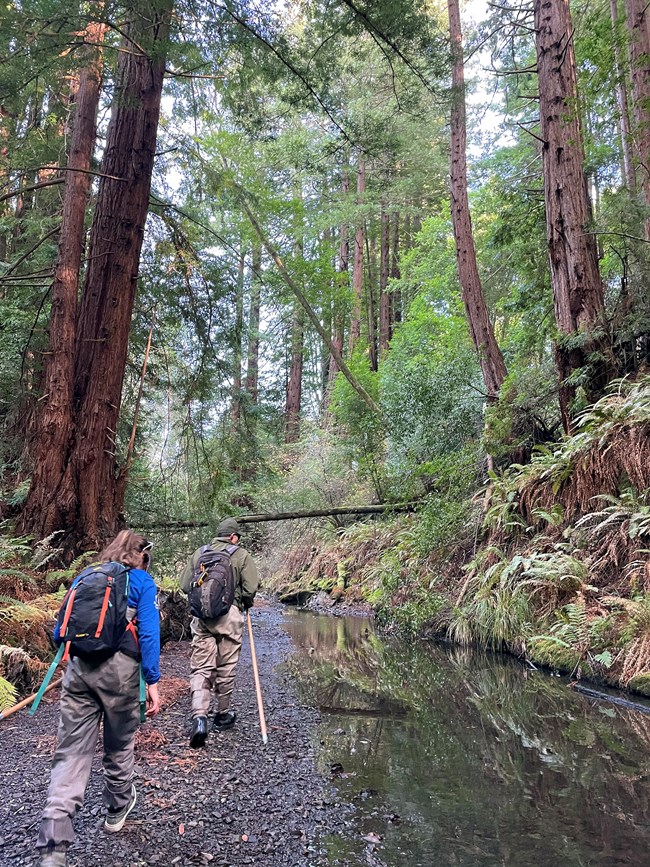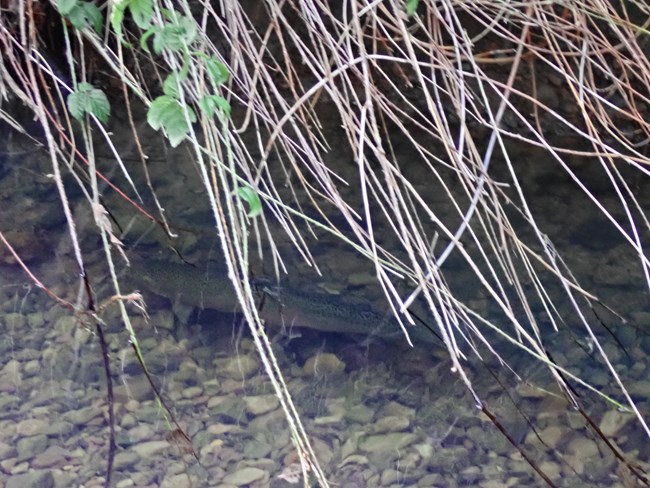Last updated: June 12, 2023
Article
Almost a Wrap: Observations from the 2022-2023 Coho & Steelhead Spawner Seasons
By Watershed Stewards Program Corpsmember Catherine Masatani, San Francisco Bay Area Network Salmonid Monitoring Program

NPS / Watershed Stewards Program Corpsmember Catherine Masatani
March 2023 - As winter transitions into spring, the 2022-2023 coho spawning season is coming to an end. Steelhead are still moving into our coastal Marin streams, but the San Francisco Bay Area Network coho and steelhead monitoring crew have not seen signs of coho since January. It’s been a season of minimal coho salmon observations: no live fish seen, only a few carcass parts collected, and a couple redds counted. A low number of returning adult coho were already expected for the season, but the impact of storms compounded these poor results. At first, more rain was needed in November to allow access for coho salmon to return to their natal streams. But then a series of winter storms caused our streams to swell, halting spawner surveys for a prolonged period of time during the peak coho spawning window.
During the 66 surveys spanning from November 9th to March 27th, we found the remains of only two coho salmon carcasses, recorded ten live steelhead, and, surprisingly, documented a Chinook female on redd. Since adult coho were only observed from mid-December to the end of January, we believe the coho spawning season ended sometime in January with minimal success. We will confirm these suspicions during our summer snorkel surveys when we count juvenile coho rearing in the streams. While the coho season has already ended, steelhead are potentially still utilizing the creeks. Their spawning season can extend into April.
Spawner Season Observation Details
Redwood Creek
For spawning to occur in Redwood Creek, enough precipitation must occur to increase streamflow and wash out the sandbar at the Muir Beach Lagoon so the stream can connect to the ocean. During the 2022-2023 season, the lagoon first breached in mid-December and has remained open since, allowing creek access to returning coho, steelhead, and Chinook. We conducted over 15 spawner surveys on Redwood Creek, but found no signs of coho. Since coho have a three-year life cycle, returning mature adults would have left Redwood Creek for the ocean as smolts during the spring of 2021. The estimated smolt abundance in 2021 was only 75, 95% CI [37, 112], and given the typical ocean survival rate (1-4%), it’s no surprise we did not see any coho. We hope at least one spawning pair was able to return to the stream in mid-January when we were unable to conduct surveys due to the atmospheric river events and corresponding high flows. Again, the most surprising find was a Chinook on her redd, seen at the end of January. The monitoring crew documented adult Chinook in Redwood Creek for the first time in our program’s history in November 2021. This unusual occurrence stemmed from a robust fall storm event. It’s possible this anomaly will become more frequent, as climate change causes shifts in weather patterns and intensity. Since the Chinook sighting, we have counted only three live steelhead, one steelhead redd, and one redd for which salmonid species could not be determined.

NPS / Michael Reichmuth
Olema Creek
Of the streams we monitor, Olema Creek had the most salmonid observations, with two coho carcasses, eight live steelhead, one steelhead carcass, two steelhead redds, and eleven redds not classified to species. All signs of coho were seen in the lower survey reaches, while steelhead were mainly recorded in upper Olema and, more specifically, Olema’s largest tributary, John West Fork. We are hopeful that some of the redds for which salmonid species could not be determined were actually coho, but we will need to wait for summer juvenile surveys to gain a better understanding of which species were able to successfully spawn.
Cheda and Pine Gulch Creeks
This year, crews recorded two steelhead redds in Pine Gulch Creek. But they saw no signs of coho after the recent return of the species to the watershed and two consecutive seasons of successful spawning in 2020-2021 and 2021-2022. Unfortunately, there were no signs of coho or steelhead spawning activity during the four surveys in Cheda Creek.
In Summary
Overall, this cohort appears to be on the decline based on long-term monitoring data. The last time crews observed this cohort spawning (2019-2020), we only recorded three coho redds in both Olema and Redwood Creek. For this reason, we will continue monitoring these important species and collecting data to aid in management and recovery strategies.
Although this year’s spawning season was not not nearly as productive as usual, we are anxiously waiting to install our smolt traps in Olema and Redwood Creeks once conditions allow. Preliminary estimates indicate that this could be a record-breaking year for out-migrating coho and we are excited to transition into our next field season!
For more information
-
San Francisco Bay Area Network Salmonid Monitoring webpage
- Pacific Coast Science & Learning Center Coho & Steelhead webpage
- Contact Fishery Biologist Michael Reichmuth
See more from the Bay Area Nature & Science Blog
